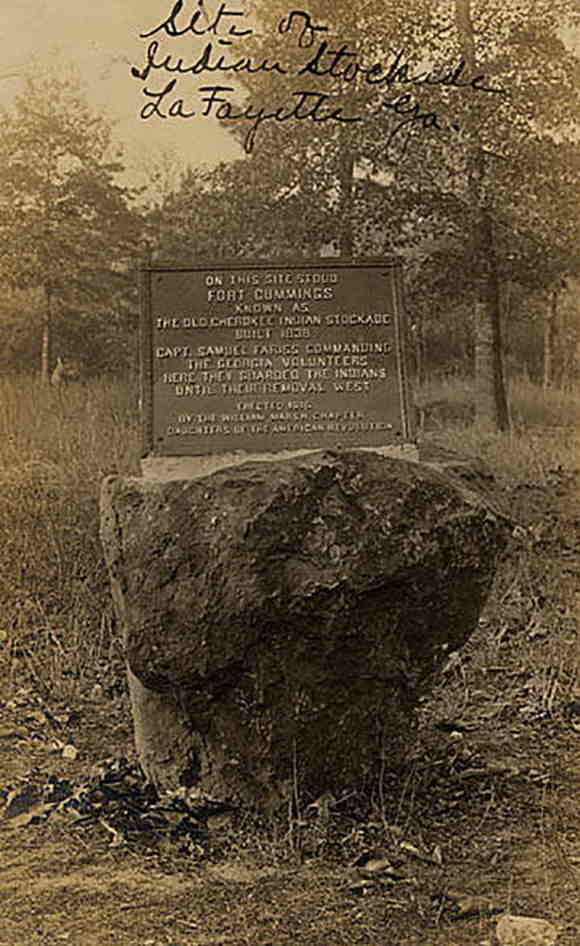Fort Cumming - Vestiges of the Trail of Tears in Georgia
Lafayette, Walker County, GA

Original marker for Fort Cumming." Image source: The Rome News-Tribune.
This article is adapted from "Cherokee Removal: Forts Along the Georgia Trail of Tears" by Sarah H. Hill.
Sources for Ft. Cumming in Lafayette included the National Archives records of the quartermaster’s department, the governors’ correspondence at the Georgia Department of Archives and History, the combined records of Cherokee removal on microfilm at the National Archives Records Administration, and the Special Collections Department of the Woodruff Library at Emory University, Atlanta. Emory houses the records of Benjamin T. Watkins, commander of a company of Georgia infantrymen stationed at Ft. Cumming. Watkins was previously unknown in the story of Ft. Cumming, and the discovery of his papers has added immeasurably to our understanding of events at the site.
Walker County citizens are heir to a long tradition of interest in Native Americans in general and the removal of the Cherokees in particular. In 1915, Mrs. Frances Park Stiles, long-time historian for the William Marsh chapter of the Daughters of the American Revolution, wrote an article about removal for the Walker County Messenger. The article includes the following description of the fort in Lafayette:
The stockade was a large enclosure of upright logs; the trenches where the logs were placed can still be plainly seen. There was a rifle tower in each corner after the manner of frontier posts, post holes were formed by sawing flared notches in the logs before they were put in the buildings. On the inside of the tower the port holes were eight or ten inches across, thus allowing room for changing the course of the rifle fire.ccc
Stiles does not cite sources, but she does name one local citizen who remembered “seeing the old fort when it was about half rotted down.” She identifies the fort site as “on the hill just west of the Big Spring where the city of Lafayette, Ga., gets its water supply.” According to Stiles, the watchtower stood on the hill adjacent to and west of the spring.ccci
The fort description by Stiles has informed the thinking of almost everyone in Georgia who is interested in the Trail of Tears. It has been repeated in numerous publications, often without credit to Stiles. Congruent with images of frontier posts, it has provided illustrators with enough detail to enable them to sketch removal posts with considerable confidence. Verifying, amending, or refuting the description remains a goal of this research.
In addition to Stiles’ work, the late Doris Hetzler of Lafayette accumulated papers related to Cherokee life and removal, and her collection is housed in the Cherokee Regional Library in Lafayette. A review of the Hetzler collection, however, produced no additional information. In 1972, James Alfred Sartain published a History of Walker County Georgia that includes descriptions of removal activities in Walker County. Sartain acknowledged that his “comprehensive review” of Cherokee removal was copied or paraphrased from various other accounts and that not all the events included actually took place in Walker County. Although not helpful regarding the Cherokee deportation, Sartain’s work has helped identify settlements and trails that were surely important during the process
Contemporary residents of the area have been particularly supportive of further research. Special mention should be made of Clayton Bell, president of the Walker County Historical Society, and Dr. David Boyle of Dalton College, both of who have been generous with time and tips for further research. Boyle and I continue a genial disagreement about the post’s name. Boyle accepts the common wisdom that the post honors the missionary David B. Cumming, who was appointed as an itinerant in 1836 by the Holston (Tennessee) Methodist Conference. Cumming’s mission circuit included Georgia and he requested reassignment to Arkansas in order to accompany the Cherokees when they were removed.cccii I have proposed a Georgia war hero, Col. William Cumming, for whom the town of Cumming, Georgia is named, as a more likely honoree. My idea derives from the fact that no other post in Georgia was named for a friend of the Indians, and most were named for someone in the military or in Georgia politics. Until more records are located, resolution of this particular disagreement remains unfulfilled.
A recent conversation with Tennessee chapter member Vicki Rozema pointed to another source of information about Cherokees in the area of Lafayette. Rozema was told that the records of the Peavine Baptist Church include the information that Cherokee prisoners were housed in the original church while waiting to be moved from Georgia to Tennessee. Efforts to contact the church are ongoing.
A state historical marker, which is now in disrepair, stands near the purported site of the post. It replaced a boulder with a small bronze marker placed at the site by the Marsh chapter some years before 1935 and subsequently stolen.
Walker County was carved out of Murray County in 1833, shortly after the Cherokee land survey. The county included Rossville and the last Georgia home of John Ross, Crawfish Town on Peavine Creek (where George Lowrey lived) and an original Cherokee courthouse, Strawberry on the Armuchee River, Dogwood on Chickamauga Creek (home of Charles Hicks), Chestnut Town on Peavine Creek, Lookout Mountain Town on Lookout Creek, Duck Town on Duck Creek in the Chattooga Valley, and White Oak Town on Spring Creek. Crawfish Town is now called Chickamauga.
Lying in the northwest portion of Georgia, the county is primarily in the Ridge and Valley physiographic province, though its western edge is part of the Appalachian Plateau. The Alabama Road (later the Brainerd Road) followed the path of least resistance in a northeast-southwest direction. When the Cherokees divided their nation into districts, the area that became Walker County was in the Chickamauga District. In 1836, the name of the town of Chattooga was changed to Lafayette.
More...
>